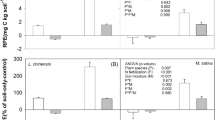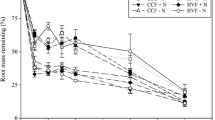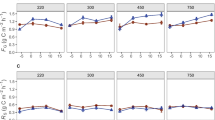Abstract
The hypothesis that roots enhance soil-N turnover in humified soil organic matter (SOM) (mull) but not in lignified SOM (mor) was tested in a study involving the growth of eight species of tree seedlings on the two contrasting humus forms. After 12 and 22 weeks of seedling growth, soil-CO2 efflux was measured with (1) growing seedlings, and after 22 weeks, with (2) roots only, shoots excised, and (3) with roots removed and soils amended with different rates of glucose. Indices of C-flux and of soil available-C were derived and compared to plant-N uptake, extractable soil mineral-N, anaerobically mineralized soil-N, N bioavailability to Agrostis grass following harvest of seedlings, and to seedling fine root C-chemistry. Significant soil x species interactions were found for total soil-CO2 efflux, root-dependent CO2, soil available-C and microbial biomass. In all cases, roots were important contributors to C-cycling in the mull soil but not in the mor soil. C was more limiting in the mor than in the mull microbial community. Plant-N uptake and the mineral-N pool was greater in the mor soil, reflecting that soil's higher specific N-supplying capacity (N-mineralized:CO2). Seedlings decreased the mineral-N pool in both soils, but the presence of roots increased N-mineralization in the mull soil and decreased N-mineralization in the mor soil. Significant positive relationships were observed in the mull soil only between soil respiration and plant N uptake at mid-season, and between soil respiration and N-mineralization at late-season. Birch root activity in the mull soil was greater than that of all other seedlings and this observation is discussed with respect to the autecology of birch. Soil respiration correlated with the non-polar extract content but not the lignin:N ratio of fine roots. Results suggest that root-released C in mull SOM is sufficient to relieve energy limitation to soil microbes and allow them to access appreciable amounts of soil-N, whereas ligninolytic activity, which may ultimately control soil-N turnover in mor SOM, is not increased by rhizodeposition.
Similar content being viewed by others
References
Aber JD, Melillo JM, McClaugherty CA (1990) Predicting long-term patterns of mass loss, nitrogen dynamics, and soil organic matter formation from initial fine litter chemistry in temperate forest ecosystem. Can J Bot 68:2201–2208
Anderson JPE (1982) Soil respiration. In: Page AL, Miller RH, Keeney DR (eds) Methods of soil analysis. II. Chemical and microbiological properties, 2nd edn. Am Soc Agron, Madison, Wis, pp 831–871
Anderson TH, Domsch KH (1978) A physiological method for the quantitative measurement of microbial biomass in soil. Soil Biol Biochem 10:215–221
Anderson TH, Domsch KH (1993) The metabolic quotient for CO2 (qCO2) as a specific activity parameter to assess the effects of environmental conditions, such as pH, on the microbial biomass of forest soils. Soil Biol Biochem 25:393–395
Bachmann G, Kinzel H (1992) Physiological and ecological aspects of the interactions between plant roots and rhizosphere soil. Soil Biol Biochem 24:543–552
Bottner P, Cortez J, Sallih Z (1991) Effect of living roots on carbon and nitrogen of the soil microbial biomass. In: Atkinson D (ed) Plant root growth. Blackwell Scientific, London, pp 201–210
Bradley RL, Fyles JW (1995) A kinetic parameter describing soil available carbon and its relationship to rate increase in C mineralization. Soil Biol Biochem 27:167–172
Buwalda JG, Fossen M, Lenz F (1992) Carbon dioxide efflux from roots of calamodin and apple. Tree Phys 10:391–401
Carlyle JC (1986) Nitrogen cycling in forested ecosystems. For Abst 47:307–336
Cheng W, Coleman DC, Carroll CR, Hoffman CA (1993) In situ measurement or root respiration and soluble C concentrations in the rhizosphere. Soil Biol Biochem 25:1189–1196
Clarholm M (1985) Interactions of bacteria, protozoa and plants leading to mineralization of soil nitrogen. Soil Biol Biochem 17:181–187
Côté B, Fyles JW (1994) Nutrient concentration and acid-base status of leaf litter of tree species characteristic of the hardwood forest of southern Québec. Can J For Res 24:192–196
Coulson CB, Davies RI, Lewis DA (1960) Polyphenols in plant, humus, and soil: I. Polyphenols of leaves, litter, and superficial humus from mull and mor sites. J Soil Sci 11:20–29
Dighton J, Thomas ED, Latter PM (1987) Interactions between tree roots, mycorrhizas, a saprotrophic fungus and the decomposition of organic substrates in a microcosm. Biol Fertil Soils 4:145–150
Dinel H, Schnitzer M, Mehuys GR (1990) Soil lipids: origin, nature, content, decomposition, and effect on soil physical properties. In: Bollag J; Stotzky G (eds) Soil biochemistry, vol 5. Marcel Dekker, NY, pp 397–429
Fleming LV (1985) Experimental study of sequences of ectomycorrhizal fungi on birch (Betula sp.) seedling root systems. Soil Biol Biochem 17:591–600
Haimi J, Huhta V, Boucelham M (1992) Growth increase of birch seedlings under the influence of earthworms — a laboratory study. Soil Biol Biochem 24:1525–1528
Hallsby G (1994) The influence of different forest organic matter on the growth of one-year old planted Norway spruce seedlings in a greenhouse experiment. New For 8:43–60
Handley WRC (1954) Mull and mor formation in relation to forest soils. Forestry Commission Bulletin (London) 23:2–4
Handley WRC (1961) Further evidence for the importance of residual leaf protein complexes in litter decomposition and the supply of nitrogen for plant growth. Plant Soil 15:37–73
Harris MM, Riha SJ (1991) Carbon and nitrogen dynamics in forest floor during short-term laboratory incubations. Soil Biol Biochem 23:1035–1041
Hendershot WH, Duquette M (1986) A simple barium chloride method for determining cation exchange capacity and exchangeable cations. Soil Sci Soc Am J 50:605–608
Holland EA, Detling JK (1990) Plant response to herbivory and aboveground nitrogen cycling. Ecol 71:1040–1049
Holmes WE, Zak DR (1994) Soil microbial dynamics and net nitrogen mineralization in northern hardwood ecosystems. Soil Sci Soc Am J 58:238–243
Howard PJA, Howard DM (1993) Ammonification of complexes prepared from gelatin and aqueous extracts of leaves and freshly-fallen litter of trees on different soil types. Soil Biol Biochem 25:1249–1256
Lambers H (1987) Growth, respiration, exudation and symbiotic associations: the fate of carbon translocated to the roots. Semin Ser Soc Exp Biol 30:125–145
Leyval C, Berthelin J (1993) Rhizodeposition and net release of soluble organic compounds by pine and beech seedlings inoculated with rhizobacteria and ectomycorrhizal fungi. Biol Fertil Soils 15:259–267
Liu GE, Côté B (1993) Neutralizing and buffering capacity of leaves of sugar maple, largetooth aspen, paper birch and balsam fir. Tree Physiol 12:15–21
Lynch JM, Whipps JM (1991) Substrate flow in the rhizosphere. In: Keister DL, Cregan PB (eds) The rhizosphere and plant growth. Kluwer Academic, Netherlands, pp 15–24
Marshall JD, Perry DA (1987) Basal and maintenance respiration of mycorrhizal and nonmycorrhizal root systems of conifers. Can J For Res 17:872–877
Melillo JM, Aber JD, Muratore JF (1982) Nitrogen and lignin control of hardwood leaf litter decomposition dynamics. Ecology 63:621–626
Miles J, Young WF (1980) The effects on heathland and moorland soils in Scotland and Northern England following colonization by birch (Betula spp.). Bull Écol 11:233–242
Miller HG (1984) Nutrient cycles in birchwoods. Proc Royal Soc Edinburgh 85B:83–96
Myrold DD (1987) Relationship between microbial biomass and a nitrogen availability index. Soil Sci Soc Am J 51:1047–1049
Nelson DW, Sommers LE (1982) Total carbon, organic carbon, and organic matter. In: Page AL, Miller RH, Keeney DR (eds) Methods of soil analysis. II. Chemical and microbiological properties, 2nd edn. Am Soc Agron, Madison, Wis, pp 539–579
Norton JM, Smith JL, Firestone MK (1990) Carbon flow in the rhizosphere of ponderosa pine seedlings. Soil Biol Biochem 22:449–455
Parmelee RW, Ehrenfeld JG, Tate RL III (1993) Effects of pine roots on microorganisms, fauna, and nitrogen availability in two soil horizons of a coniferous forest spodosol. Biol Fertil Soils 15:113–119
Powers RF (1980) Mineralizable soil nitrogen as an index of nitrogen availability to forest trees. Soil Sci Soc Am J 44:1314–1320
Ryan MG, Melillo JM, Ricca A (1990) A comparison of methods for determining proximate carbon fractions of forest litter. Can J For Res 20:166–171
Rygiewicz PT, Andersen CP (1994) Mycorrhizae alter quality and quantily of carbon allocated below ground. Nature (London) 369:58–60
Sakamoto K, Oba Y (1994) Effect of fungal to bacterial biomass ratio on the relationship between CO2 evolution and total soil microbial biomass. Biol Fertil Soils 17:39–44
Sallih Z, Bottner P (1988) Effect of wheat (Triticum aestivum) roots on mineralization rates of soil organic matter. Biol Fertil Soils 7:67–70
SAS Institute Inc (1984) SAS/EST Users guide. Statistics Version 5. SAS Institute Inc, Cary, NC
Tate III RL, Parmelee RW, Ehrenfeld JG, O'Reilly L (1991) Nitrogen mineralization: root and microbial interactions in pitch pine microcosms. Soil Sci Soc Am J 55:1004–1008
Waring SA, Bremner JM (1964) Ammonium production in soil under waterlogged conditions as an index of nitrogen availability. Nature (London) 201:951–952
Wilkinson L (1990) Systat: The system for statistics. Systat Inc, Evanston, II
Author information
Authors and Affiliations
Rights and permissions
About this article
Cite this article
Bradley, R.L., Fyles, J.W. Interactions between tree seedling roots and humus forms in the control of soil C and N cycling. Biol Fertil Soils 23, 70–79 (1996). https://doi.org/10.1007/BF00335821
Received:
Issue Date:
DOI: https://doi.org/10.1007/BF00335821




